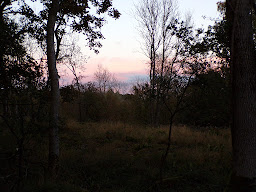Transatlantic Tourist Returns
The first Saturday in October brought a seasonal mix of warm sunny spells but also very much a taste of autumn beginning to flex its muscles, not least in the blend of wildlife on show as I visited the Arnside and Silverdale stretch of reserves. I started at Leighton Moss RSPB for my first full visit since reopening and spent fifteen minutes watching the comings and goings at the birdfeeders behind the visitor centre. By far the most abundant visitors were coal tits with half a dozen or so stocking up on the seed. Usually quite low down the pecking order at the bird-table, in the absence of great and blue tits they were definitely making hay on this occasion. They were joined by goldfinch, chaffinch, dunnock and an occasional marsh tit. Given their almost-identical appearance it's very thoughtful of marsh and willow tits to have pretty strict geographical zones in this part of the country. The scarce willow tit is very much a local speciality around my home location but here at Leighton Moss it's almost exclusively marsh tits.
Goldfinch youngster Marsh Tit Coal Tit
The only hide open on the main reserve is Lillian's and on the wide open water shoveler, gathering numbers of teal and greylag geese bobbed whilst a grey heron was intently frozen on its fishing. We headed off to the causeway and the public hide, passing the vibrant autumn colours of the hawthorn hedge and the slightly sickly-sweet aroma of the ivy which was drawing in swarms of wasps and hoverflies and a couple of red admirals. Midway down the causeway the large public hide looks out over what I consider one of my favourite views with the mere and views of Hutton Roof escarpment in the distance. Much closer though was an odd-looking duck bobbing amongst a small group of pochard and which I determined was the elusive ring-necked duck. This American vagrant had first appeared in the area the previous winter when it spent the festive season at nearby Pine Lake holiday park and it had first reappeared a few weeks ago. It seems I was fortunate to enjoy a decent view of it as it apparently spent most of its time on this occasion fast asleep, but it was obliging enough to give me a proper view and to fire off some photos.
As evening began to draw in a final port of call was the relatively new nature reserve at Fell End, a small but nicely mixed habitat of limestone and deciduous woodland surrounding a large area of rough pasture with a couple of small pools. The pools were swarming with teal and more ducks began to drop in as the evening progressed. The Highland cows which are used to naturally manage the pasture were browsing their way around the perimeter and as light began to fade eight fallow does emerged from the wood to graze. As we returned to the cars in gathering dusk the bat detector picked up a pipistrelle busily working its way up and down the edge of the pasture.
As the afternoon drew on it was off to the saltmarsh hides on the edge of Morecambe Bay. At this time of year these are a hotspot for waders on their migration routes or gathering in their winter flocks but with the sun dipping towards the west it was quite tricky to get positive IDs. Eventually we worked out that the majority of the birds today were lapwing and redshank and most of them were catching a break from feeding and dozing on the mudbanks. Far more active were the little egrets and in the windy conditions they were having a bit of a bad hair day. Shelduck, wigeon and two redhead goosanders were the wildfowl interest beside the resident greylags and a sparrowhawk caused a bit of panic when it darted through along the reedbed.












Lovely and very interesting read as always. Great to see a photo of the Marsh Tit and it is very similar to the Coal Tit.
ReplyDelete